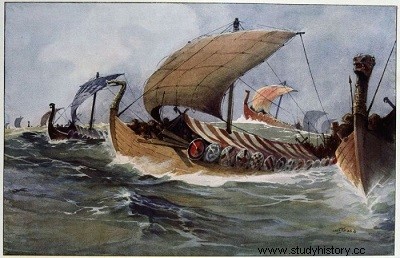
The Great Heathen Army, also called the "Great Danish Army" or simply "Grande Armée" is a Viking army from Denmark which plundered and conquered a large part of England at the end of the 9th century. Even if, unlike many other Scandinavian formations which operated at that time, the sources that have come down to us give us no precise indication of its numbers, it was clearly among the largest forces of its kind, gathering several hundred ships and several thousand men.
Grand Army raids into Britain (865-878).
The expression "Great Heathen Army" (in:Great Heathen Army, in OE:mycel heathen here) is used in the Anglo-Saxon Chronicle. The indications concerning it come for the most part from these annals.
The origins of the Grande Armée can be traced back to the band of Viking warriors who besieged Paris in 845, perhaps led by the legendary Ragnar Lodbrok. They then attacked the surrounding area, plundering Rouen and other smaller towns several times, perhaps striking from easily defensible bases established in the area of their depredations.
After honing their skills across continental Europe, the army set out for Britain and landed in East Anglia in 865. Their goal was to conquer England and establish themselves there. It was led by Halfdan and Ivar Ragnarsson, known as "the Boneless", with the assistance of their brother Ubbe. The Norse sagas see the invasion as a retaliatory operation in response to the death of their father, Ragnar Lodbrok, at the hands of King Ælle of Northumbria, but the historicity of this rationale is uncertain.
At the end of 866, the army conquered the kingdom of Northumbria, followed in 870 by that of East Anglia. In 871, the Great Summer Army3 arrived from Scandinavia, led by Bagsecg. In 874, the men of the Great Heathen Army, thus reinforced, were able to conquer Mercia, driving out King Burgred. In the same year, a large number of them settled in the conquered territories, followed in 877 by another group. Evidence of their stay was provided by the mass grave of 250 bodies discovered at Repton and by the fifty or so burial mounds found nearby in Ingleby, Derbyshire.
After the conquest of Mercia, the Great Army split:Halfdan moved north to attack the Picts, while in the south Guthrum asserted his authority as a warlord. He and his men followed the usual Danish strategy:occupy a fortified town and then seek a favorable peace treaty, usually money in return for a promise to immediately abandon the land. In 876 the assembled troops of Halfdan and Guthrum were joined by further reinforcements and together won the Battle of Wareham.
However, Alfred the Great, who reigned over Wessex, the only Anglo-Saxon kingdom that remained independent, counter-attacked and confronted the Great Army in 878 at Ethandun; By forming a rampart of their shields, analogous to the tortoise formation of the Roman legions, the Saxons gained the advantage and, albeit with difficulty, won the victory. The Danes retreated and took refuge in Chippenham. Their surrender, after 14 days of siege, opened the way to a peace treaty by which Guthrum agreed to be baptized by taking Alfred as his godfather.
The Danes therefore remained confined to what was to be called the Danelaw; Wessex was freed from the threat they posed. To the north, settlers from the army formed the Viking kingdom of York, which continued with several interruptions until the middle of the 10th century.
